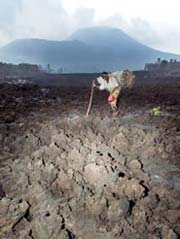Seismic rumbling foretold Congo eruption

Evacuees leaving Goma after the lava flows. <br>© AP <br>
Scientists received several day’s warning of abnormal seismic activity.
Two seismological stations on Mount Nyiragongo in eastern Congo gave several days’ advance warning of the volcano’s possible eruption, scientists working in the area say.
But the lack of a functioning government in the war-torn region may have prevented the evacuation of the nearby city of Goma, where 45 were confirmed dead and an existing humanitarian crisis was worsened by the eruption.
For the past decade, a Japanese team has sought to maintain a seismic network at the volcano. In 1994, five monitoring units were donated by the US Geological Survey’s Volcano Disaster Assistance Program (VDAP) to form the Goma Volcano Observatory.
But fighting in the area and looting of equipment by armed militia camped on the volcano itself regularly forced volcanologists to flee, according to Jacques Durieux, director of the Active Volcanoes Study Group in Lyon, France, who last visited Mount Nyiragongo with VDAP scientists in 1994.
According to the VDAP, only two monitoring stations were working properly before the eruption. VDAP scientists nevertheless received a warning on 12 January – five days before the first eruption – of the possibility of “abnormal seismic activity”.
Durieux, who spoke with Congolese volcanologists on the day of the eruption, says that efforts were made to raise the alarm, but the lack of governance in Goma makes it unlikely that any plan to evacuate the city could have been implemented. Local volcanologists “have no staff and no pay”, says Hawaii-based volcano consultant Jack Lockwood, who has accompanied Durieux on previous trips to Mount Nyiragongo.
Durieux now wants to improve the observation of Mount Nyiragongo and its neighbour, Mount Nyamuragira, some 14 km away, which is also active. But he says that “we can’t expect developing countries to pay”.
Mount Nyiragongo last erupted in 1977, killing around 500 people, and threatened to do so again in June 1994, when some 800,000 refugees from Rwanda’s civil war were camped on its slopes. Last week’s eruption was the largest in the volcano’s history, according to geological evidence.
Predicting future eruptions of an active volcano such as Nyiragongo will require a far more elaborate monitoring system than the two stations currently in place, say VDAP scientists. The VDAP and other agencies have provided more comprehensive monitoring of volcanoes elsewhere in the developing world, but such monitoring is only carried out at the request of the host government. With the province of North Kivu, where Goma is situated, controlled by Rwandan-backed rebels, such a request was not forthcoming from the government of the Democratic Republic of Congo in Kinshasa, say VDAP officials.
Media Contact
All latest news from the category: Earth Sciences
Earth Sciences (also referred to as Geosciences), which deals with basic issues surrounding our planet, plays a vital role in the area of energy and raw materials supply.
Earth Sciences comprises subjects such as geology, geography, geological informatics, paleontology, mineralogy, petrography, crystallography, geophysics, geodesy, glaciology, cartography, photogrammetry, meteorology and seismology, early-warning systems, earthquake research and polar research.
Newest articles

Superradiant atoms could push the boundaries of how precisely time can be measured
Superradiant atoms can help us measure time more precisely than ever. In a new study, researchers from the University of Copenhagen present a new method for measuring the time interval,…

Ion thermoelectric conversion devices for near room temperature
The electrode sheet of the thermoelectric device consists of ionic hydrogel, which is sandwiched between the electrodes to form, and the Prussian blue on the electrode undergoes a redox reaction…

Zap Energy achieves 37-million-degree temperatures in a compact device
New publication reports record electron temperatures for a small-scale, sheared-flow-stabilized Z-pinch fusion device. In the nine decades since humans first produced fusion reactions, only a few fusion technologies have demonstrated…





















